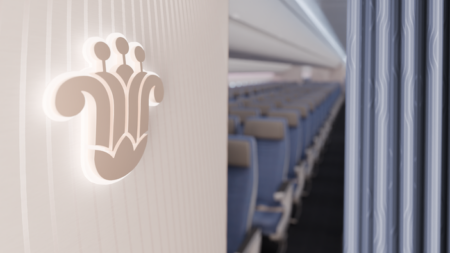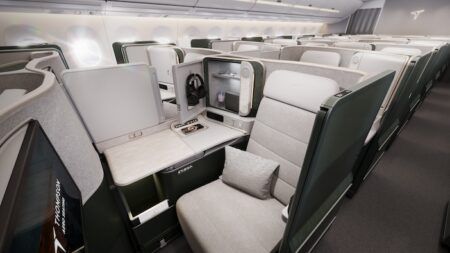Virgin Atlantic and Airbus have announced an agreement on a firm order, valued at US$4.4 billion, for 12 Airbus A350-1000 aircraft, with eight to be purchased and four leased.
The investment forms part of the airline’s fleet modernization program, which will see half of its aircraft fleet – its eight Boeing 747-400s and eight Airbus A340-600s – replaced over a six-year period, beginning when the first A350 enters service in early 2019.
So what can passengers expect in the cabin experience? The airline has stated that the aircraft will be delivered to Virgin Atlantic in two configurations – one for the business fleet on key routes such as London Heathrow to New York JFK, seating up to 360 customers, and one for the leisure fleet, seating up to 410 customers.
According to the airline, its passenger experience team – led by Reuben Arnold – is currently undertaking in-depth research on the cabin design, and is including key customers in the process. The design team will be working within the new Airspace by Airbus cabin architecture, which offers a ‘blank canvas’, with white finishes that optimize lighting effects. The Virgin Atlantic design team used a similar principle of ‘painting’ a white cabin with light on the Dreamliner, as you can read HERE.
A little speculation
Let’s hazard a few guesses of what the Virgin Atlantic A350 experience will include…
A bar area: The Upper Class bar has become a key part of the Virgin Atlantic brand experience. Indeed, the airline’s research has found that the Door 2 bar area creates a positive sentiment among many economy passengers when they pass it during boarding, even though they cannot use this feature. We fully expect to see a bar on on board the A350, but we also fully expect it to be a new design.
The Upper Class bar design has steadily evolved from aircraft to aircraft, with the original B747 version’s straightforward layout evolving into a bright and bold angled design for the A330, and to a more toned-down version for the B787. For the A350 we predict further evolution of the design, with a focus on creating a sophisticated feel.
Below: The B787 bar area was a major design project, and a key one as it is the sight that greets every passenger when boarding. The mood lighting in the space adjusts according to flight phase
Business class: The Upper Class Suite has also evolved between aircraft, with subtle changes to the aesthetic keeping the experience fresh while still being recognizable and consistent in operation across the fleet. The bigger differences have happened beneath the surface, as space and comfort have been steadily refined. While some have criticized the ‘flip over’ bed deployment, which requires the passenger to leave the seat while the bed is prepared, the turn-down service is part of the Upper Class experience and creates a nice opportunity for the crew to interact with the passengers. The Upper Class Suite is also a familiar layout to business class flyers with codeshare partners Delta and Air New Zealand.
Above: The B787 Upper Class cabin offers direct aisle access for all
To maintain fleet consistency, especially with the recently launched B787 product, we predict a similar suite on the A350, with some subtle changes to optimize the use of the wide cabin and to create a little extra space and comfort.
In the main cabin, we also expect the airline will make use of the 18in minimum economy seat width, which Airbus promotes as a key selling point.
IFE: Given the relatively short time until the early 2019 launch, and for consistency with the B787 fleet, the A350s are likely to feature Panasonic eX3 IFE systems.
However, this is Virgin Atlantic, an airline that likes to surprise. Whatever the passenger experience team devise, the Virgin design is likely to be one of the most exciting A350s in the sky. Roll on 2019!
Adam Gavine




